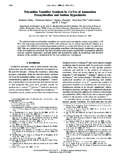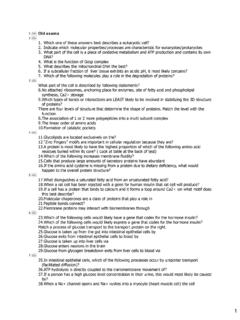Transcription of Targeted nanoparticles for drug delivery through the blood ...
1 Targeted nanoparticles for drug delivery through the blood brainbarrier for Alzheimer s diseaseBCeleste Roneya, Padmakar Kulkarnia, Veera Aroraa, Peter Anticha,Frederick Bontea, Aimei Wub, Mallikarjuanab, Sanjeev Manoharb,Hsiang-Fa Liangc, Anandrao R. Kulkarnic, Hsing-Wen Sungc,Malladi Sairamd, Tejraj M. Aminabhavid,*aDepartment of Radiology, Division of Advanced Radiological Sciences, The University of Texas Southwestern Medical Center at Dallas,Dallas, TX 75390, United StatesbAlan G. MacDiarmid Laboratory for Scientific Innovation, Department of Chemistry, The University of Texas at Dallas, Richardson,TX 75083, United StatescDepartment of Chemical Engineering, National Tsing Hua University, Hsinchu, Taiwan 30013, ROCdDrug delivery Division, Center of Excellence in Polymer Science, Karnatak University, Dharwad, 580 003, IndiaReceived 7 March 2005; accepted 24 July 2005 Available online 24 October 2005 AbstractAlzheimer s disease (AD) is the most common cause of dementia among the elderly, affecting 5% of Americans over age65, and 20% over age 80.
2 An excess of senile plaques (h-amyloid protein) and neurofibrillary tangles (tau protein), ven-tricular enlargement, and cortical atrophy characterizes it. Unfortunately, Targeted drug delivery to the central nervous system(CNS), for the therapeutic advancement of neurodegenerative disorders such as Alzheimer s, is complicated by restrictivemechanisms imposed at the blood brain barrier (BBB). Opsonization by plasma proteins in the systemic circulation is anadditional impediment to cerebral drug delivery . This review gives an account of the BBB and discusses the literature onbiodegradable polymeric nanoparticles (NPs) with appropriate surface modifications that can deliver drugs of interest beyondthe BBB for diagnostic and therapeutic applications in neurological disorders, such as AD.
3 The physicochemical propertiesof the NPs at different surfactant concentrations, stabilizers, and amyloid-affinity agents could influence the Elsevier All rights : blood brain barrier; Alzheimer s disease; nanoparticles ; Targeted drug delivery ; Central nervous system0168-3659/$ - see front matterD2005 Elsevier All rights article is CEPS communication # 67.* Corresponding author. Fax: +91 836 ( Aminabhavi).Journal of Controlled Release 108 (2005) 193 1942. blood brain Biology of the Molecular physiology of the BBB breakdown and mechanisms of drug transport to the barrier and targeting 1983. Polymeric Production of nanoparticles by different Emulsion Dispersion Interfacial polymerization/denaturation and desolvation.
4 nanoparticles and the BBB 2034. Alzheimer s Genomics and proteomics of The metallochemistry of AD/oxidative 2085. nanoparticles and Alzheimer s Quinoline 2106. 2121. IntroductionAlzheimer s disease (AD), a neurodegenerativedisorder of the elderly, is the most prevalent formof dementia. The cognitive decline associated withAD drastically affects the social and behavioral skillsof people living with this disease. Notwithstandingthe social impact, however, AD also imparts greatfinancial burdens on patients, families, and the com-munity as a whole. The National Institutes of Health(NIH) estimates that million Americans areaffected by AD, at an annual cost of $100 billionper year.
5 Yet even more ominous is the estimate thatby 2050, million older Americans are expectedto have AD if the current trends hold and no pre-ventive treatment becomes available. These statisticsare exacerbated by the fact that there are no currentbiological markers of AD, and therefore, definitivediagnoses are made upon autopsy and new treatmentefficacy cannot be extended overtime. Furthermore,therapeutic strategies to probe the central nervoussystem (CNS) are limited by the restrictive tightjunctions at the endothelial cells of the blood brainbarrier (BBB). To overcome the impositions of theBBB, polymeric biocompatible drug carriers havebeen applied to the central nervous system formany applications such as cancers, but the field ofnanoparticulate drug carrier technology is not welldeveloped in AD research[1].
6 Polymeric nanoparti-cles are promising candidates in the investigation ofAD because nanoparticles are capable of: openingtight junctions[2]crossing the BBB[3], high drugloading capacities, targeting towards the mutagenicproteins of Alzheimer s[4,5]. The present reviewgives an account of BBB and discusses the literatureon biodegradable polymeric nanoparticles (NPs) withappropriate surface modifications that can deliverdrugs of interest beyond the BBB for diagnosticand therapeutic applications in neurological disorders,particularly blood brain barrierThe blood brain barrier (BBB) is the homeostaticdefense mechanism of the brain against pathogens andC.
7 Roney et al. / Journal of Controlled Release 108 (2005) 193 214194toxins. Complex and highly regulated, the BBBscreens the biochemical, physicochemical and struc-tural features of solutes at its periphery, thus affordingbarrier selectivity in the passage of desired moleculesinto the brain parenchyma. Early revelations of theBBB illustrated its biological character in the murinemodel, and provided insights into contemporaryunderstandings of its physiology. Electron micro-scopic analyses of isolated cerebral cortices, postintravenous injection of the enzymatic tracer horse-radish peroxidase (HRP), exposed the presence ofexogenous HRP in the vascular space and in endothe-lial cell pinocytotic vacuoles[6].
8 The pinocytoticvacuoles were not found to transport the enzyme,and furthermore, no peroxidase was found beyondthe vasculature endothelium, suggesting abbarrierQbetween the blood and the Biology of the BBBC erebral capillaries are created by the process ofangiogenesis, which is the development of blood ves-sels from those existing in previously formed 1shows a depiction of the cerebralcapillaries, while the features of the BBB are exhibitedinFig. 2. During angiogenesis, endothelial cells (EC)Fig. 1. Characteristic features of BBB are represented in this schematic diagram of a cerebral capillary viz., tight junctions and scarcity ofpinocytic vacuoles.
9 Note the presence of mitochondria, which are denser in cerebral EC as compared to peripheral EC. This may beattributed to extra metabolic workload required to maintain ionic gradients at BBB (figure taken from: Burns E., Dobben G., Kruckeberg T.,Gaetano P., blood brain barrier: Morphology, physiology, and effects of contrast media, Adv. Neurol., 30, (1981) 159 165, Carney A. Ed.,Raven Press NY).C. Roney et al. / Journal of Controlled Release 108 (2005) 193 214195traverse the extracellular matrix (ECM) and degradethe basement membrane to create a microvascular net-work[6,7]thus subsequent proliferation. Proliferationof endothelial cells is influenced by neural determi-nants.
10 These confer the characteristic physiologicalproperties upon the BBB, and consequently, cerebralEC are distinguished from the EC of the periphery. Forinstance, the brain EC have fewer endocytotic vesselsthan peripheral EC, which limits the transcellular fluxat the BBB. The occluded tight junctions, whose greatelectrical resistance imposes barriers to paracellularflux, join endothelial cells of the brain. The structuralproperties of cerebral EC, mentioned above, help todefine the selectiveness at the BBB. Furthermore, cer-ebral EC have more mitochondria[7]than peripheralEC, which drives the increased metabolic workloadnecessary to maintain ionic gradients across the electron-dense layers of the basement mem-brane fuse EC and astrocytes, while dividing EC andpericytes from the surrounding extracellular lie along the outer axes of cerebral capil-laries and perform in contractility.



